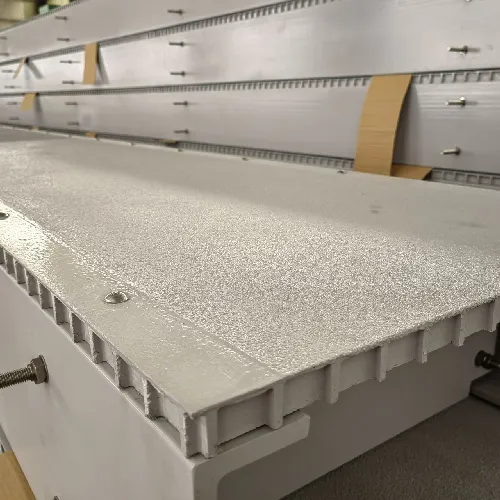loading...
- No. 9, Xingyuan South Street, Dongwaihuan Road, Zaoqiang County, Hengshui, Hebei, China
- admin@zjcomposites.com
- +86 15097380338
- Welcome to visit our website!
Innovative Applications of GFRP Rods in Modern Construction and Engineering Solutions
Understanding GFRP Rods A Composite Solution for Modern Engineering
Glass Fiber Reinforced Polymer (GFRP) rods have emerged as a vital component in many engineering applications due to their unique properties and advantages over traditional materials like steel. GFRP rods are composed of a polymer matrix reinforced with glass fibers, which enhances their strength and durability while remaining lightweight. This article explores the characteristics, benefits, applications, and future prospects of GFRP rods in the construction and civil engineering industries.
Characteristics of GFRP Rods
The primary characteristic of GFRP rods is their composite structure, which combines the lightweight nature of polymers with the tensile strength of glass fibers. Density is one of the most appealing properties of GFRP; it is significantly lower than that of steel, allowing for easier handling and installation. Additionally, GFRP rods possess excellent resistance to corrosion and environmental degradation, making them suitable for various applications, particularly in harsh environments.
GFRP materials are also non-magnetic and do not conduct electricity, which makes them ideal for use in applications where electromagnetic interference must be minimized, such as in certain types of electronic equipment. Furthermore, GFRP rods have a high strength-to-weight ratio, making them exceptionally strong for their size, and they can be manufactured in various diameters and lengths to meet specific project requirements.
Benefits of GFRP Rods
One of the most significant benefits of GFRP rods is their superior durability. Unlike steel, which can rust and corrode over time when exposed to moisture and other environmental elements, GFRP rods maintain their integrity and performance even in extreme conditions. This characteristic is particularly advantageous in coastal areas or regions with heavy precipitation where traditional materials may fail over time, leading to increased maintenance costs.
Another advantage is the ease of installation. Because GFRP rods are lightweight, they reduce the overall burden on construction teams, allowing for faster and more efficient installations. This characteristic not only accelerates project timelines but also reduces labor costs, making GFRP rods a cost-effective choice in the long run.
Moreover, GFRP rods are considered eco-friendly. Their production process typically consumes less energy compared to traditional materials, and their longevity helps reduce the frequency of replacements, thereby minimizing waste in landfills.
gfrp rod

Applications in Engineering
GFRP rods have found numerous applications in the construction and civil engineering sectors. One notable use is in reinforced concrete structures, where they can replace steel reinforcing bars (rebar). This is particularly valuable in structures exposed to highly corrosive environments, such as bridges, tunnels, and marine structures.
In addition, GFRP rods are used in soil stabilization projects, providing necessary support and reinforcement for retaining walls and other earth structures. Their lightweight nature contributes to easier installation, which is crucial for maintaining the safety and stability of the construction site.
GFRP technology is also being explored in other sectors such as transportation, where they are used to reinforce components in vehicles and infrastructure, as well as in renewable energy applications, particularly in wind turbine blades, due to their lightweight and strong characteristics.
Future Prospects
The future of GFRP rods in engineering looks promising, with ongoing research and development aimed at improving their properties and expanding their applications. As technology advances, we can expect to see enhancements in the production methods of GFRP, leading to even more efficient, sustainable, and high-performance products.
The increasing focus on sustainability in construction processes also aligns well with the adoption of GFRP materials. As engineers and architects continue to seek out materials that reduce environmental impact and improve the lifecycle of structures, GFRP rods are likely to gain more prominence in upcoming projects.
In conclusion, GFRP rods represent a significant advancement in materials science, offering a compelling alternative to traditional materials in various engineering applications. Their unique blend of strength, durability, and lightweight characteristics ensures that they will play a crucial role in shaping the future of construction and civil engineering, delivering solutions that meet the demands of modern infrastructure while promoting sustainability.
-
The Rise of FRP Profiles: Strong, Lightweight, and Built to LastNewsJul.14,2025
-
SMC Panel Tanks: A Modern Water Storage Solution for All EnvironmentsNewsJul.14,2025
-
GRP Grating: A Modern Solution for Safe and Durable Access SystemsNewsJul.14,2025
-
Galvanized Steel Water Tanks: Durable, Reliable, and Ready for UseNewsJul.14,2025
-
FRP Mini Mesh Grating: The Safer, Smarter Flooring SolutionNewsJul.14,2025
-
Exploring FRP Vessels: Durable Solutions for Modern Fluid HandlingNewsJul.14,2025
-
GRP Structures: The Future of Lightweight, High-Performance EngineeringNewsJun.20,2025
